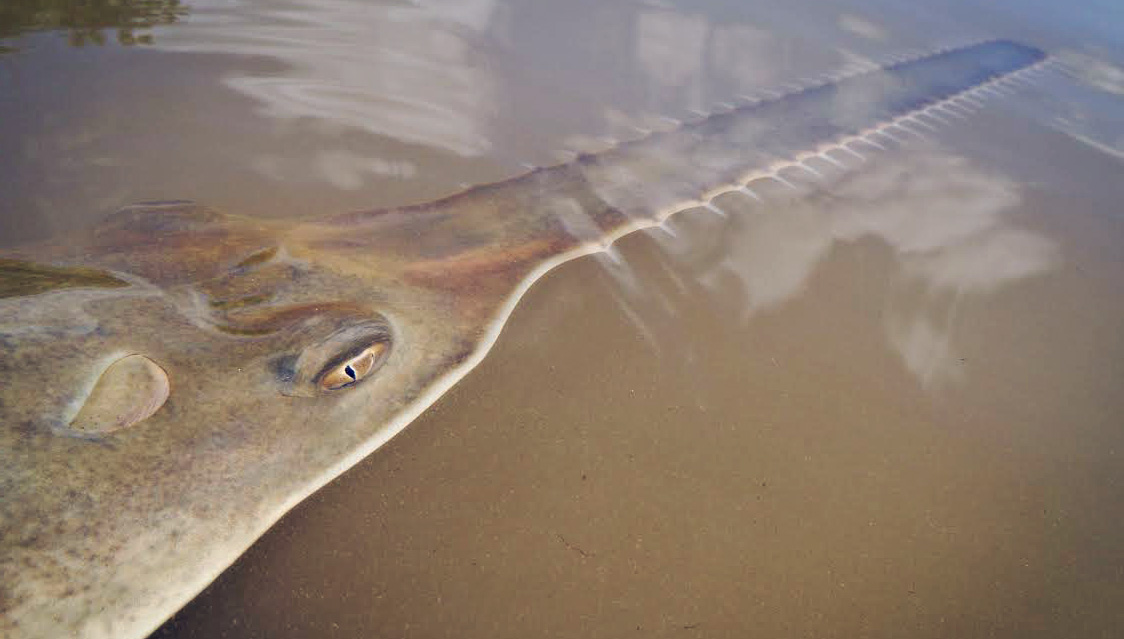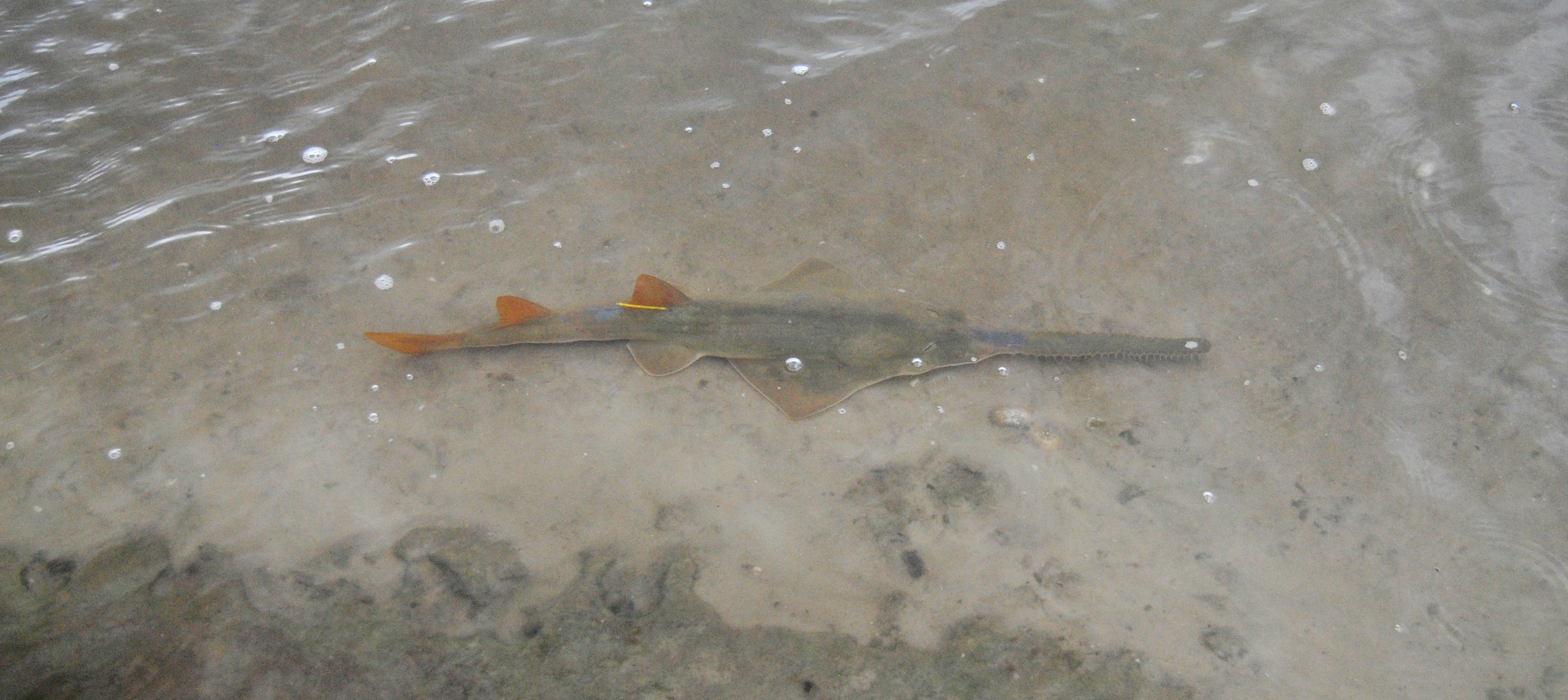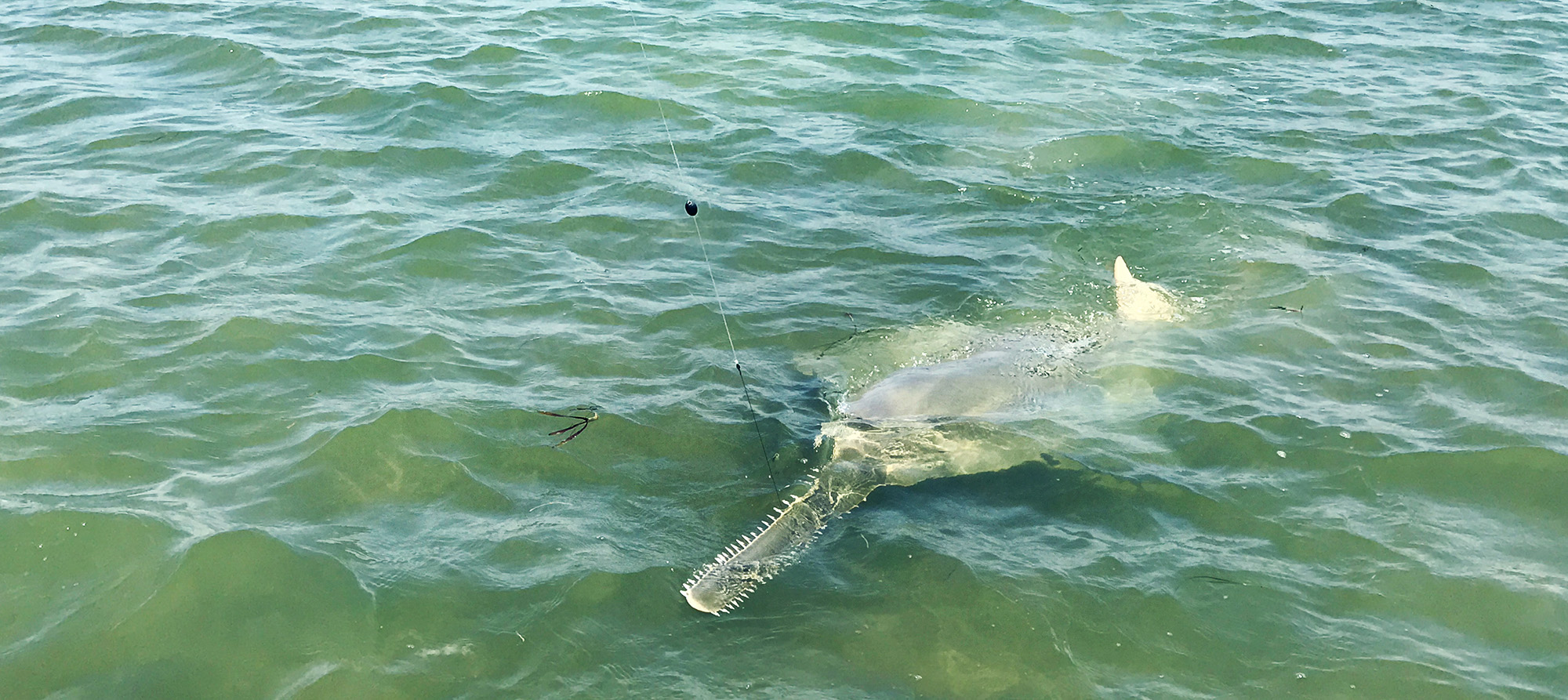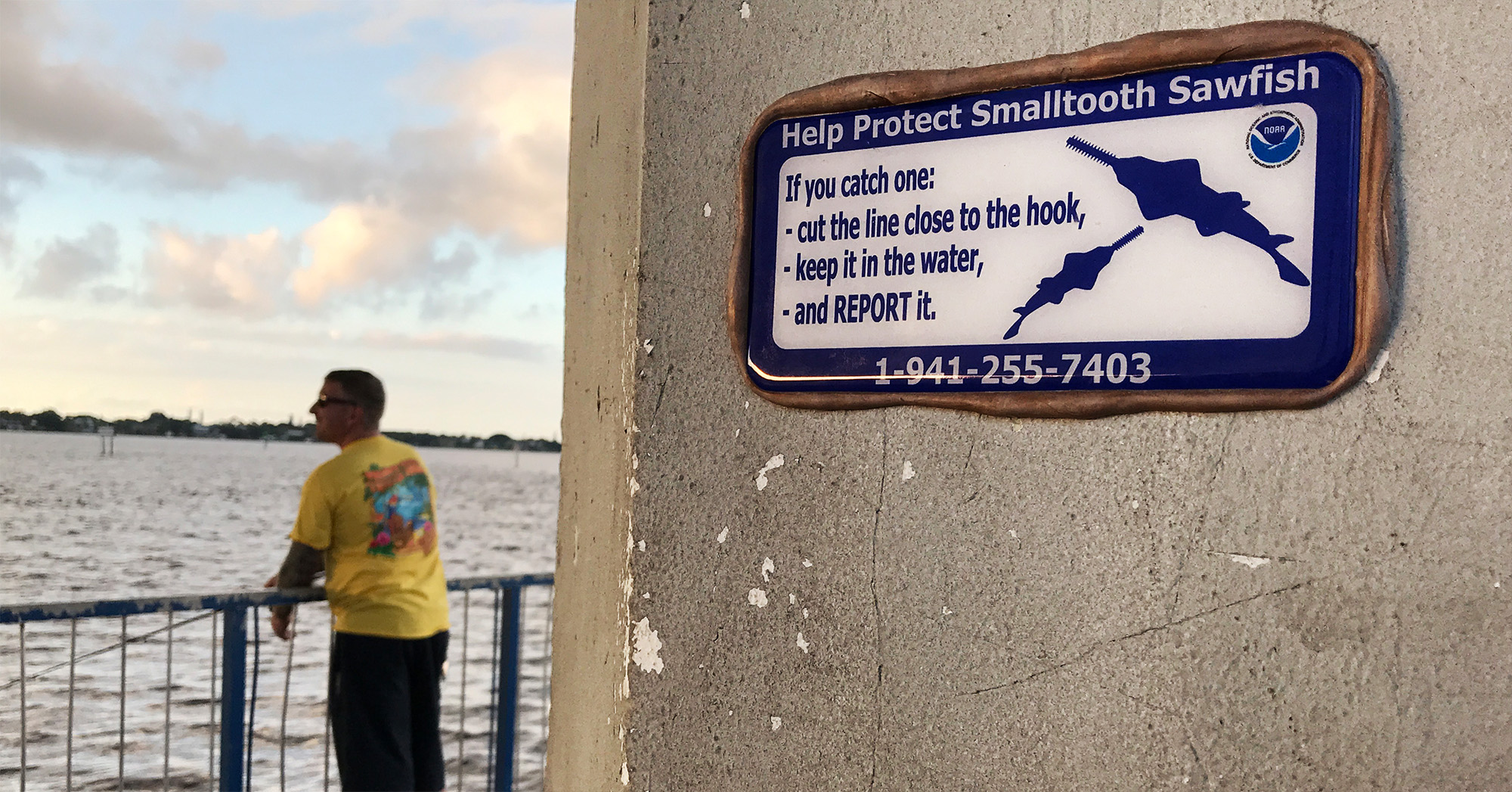August 07, 2017
By Florida Sportsman Editor
A giant of our coasts cut down, now slowly returns
 Photo credit: Dana Bethea, NOAA Fisheries
Photo credit: Dana Bethea, NOAA Fisheries
“The sawfish is an abundant species, permanently resident in Indian River, where it does considerable damage to the fishermen by becoming entangled in their nets…Several very large ‘saws' were seen at Eden, Stuart, and elsewhere, the largest being 6 feet long, thus indicating a fish of 12 or 15 feet. One fisherman has seen them 16 or 17 feet long.
“Another reports that a sawfish 12 ½ feet long and weighing 425 pounds was caught near Eau Gallie in October, 1895. He thinks that fully 300 sawfish were taken in his nets last season.” —The Fisheries of Indian River, Florida, published 1897
Florida is one of the best states in the U.S. to live alongside other big animals and predators of land and sea. If you consider the density of population on our coasts, it may even be a better place than Alaska for human/big animal cohabitation. With that privilege—if you'd call it that, and I would—come manageable dangers and the responsibility to know how to behave around those creatures—which in most cases, for most people, means not to handle them at all, and if they're encountered, let them go their way as quickly and freely as possible.
As human populations rise in Florida and populations of bear, alligator, panther, manatee and other big critters remain steady or improve thanks to sound management, encounters with these animals are becoming more frequent. One of these species, the smalltooth sawfish, appears to be rebounding from dire straits since being listed under the Endangered Species Act in 2003 during a prolonged decline that started more than a hundred years before. NOAA estimates that sawfish numbers have declined 95 percent, or more, over the past century.
By 2003, reported sightings and encounters were abysmally low around the state. Habitat loss and especially commercial net fishing imperiled the species. Their saws easily catch and tangle in fishing nets, most often killing them. The species takes a long time—7 to 11 years—to reach sexual maturity. Such a prolonged reproductive rate makes the sawfish even more vulnerable.
“We know the sawfish have suffered a very significant decline,” says John Carlson, Research Biologist at NOAA and a sawfish specialist. “We don't know how close they were to becoming extinct, but they went under some very significant decline. They are also one of the most threatened species globally. There are five species of sawfish worldwide and all of them are either endangered or critically endangered. It's a very similar pattern across the world as we've seen in the U.S.
"I've been doing some work in West Africa recently," Carlson explained, "and there are historic records where we've seen their range contract to a very, very small area, just as it has here in the U.S. As for one of the other species of sawfish that we once had in U.S. waters, the largetooth, we have not had a record of a largetooth in Texas since 1950 and now there are only isolated reports of them in Central America and South America. ”
Since 2003, however, the tide appears to have turned to the positive on sawfish survival and reproduction in Florida.
“The Florida net ban [enacted in ‘95] has likely had a very positive impact on slowing the decline of the species,” says Adam Brame, NOAA's Sawfish Recovery Coordinator, who orchestrates outreach and education efforts through media and public interaction. “Also, today, coastal construction is more regulated for environmental concerns. The historic threats continue, though at lesser levels. Sawfish are still caught incidentally in commercial and recreational fisheries and nursery habitat continues to be developed.”
 NOAA researchers collecting data on a big sawfish at a reef before release.
NOAA researchers collecting data on a big sawfish at a reef before release.
In 2009, NOAA Fisheries designated critical habitat to protect young sawfish. The two designated units of critical habitat are the Charlotte Harbor Estuary Unit and the Ten Thousand Islands/ Everglades Unit, which share the two features that are essential to the conservation of the species: red mangrove shorelines and shallow, euryhaline waters (wide-ranging salinity) with depths of less than 3 feet at mean lower low water.
“Red mangroves are used for nurseries by juvenile sawfish because that mangrove species is most commonly closest to shore,” says Brame. “The sawfish are in there for protection and to forage. Additionally, we're studying what there is about the distribution and structure of the mangrove roots—the overhang of the roots, the kind of shade that they make—that make them habitable to sawfish. We definitely seem to find areas where sawfish occur more commonly so we're trying to find out what it is about the mangrove structure that they like.”
“What they like,” Carlson adds, “might also be related to the adjacent habitat that they prefer, the kind of sloping, sandy, shallow shore where the young are often found. We're really diving in deep to get an idea of what the sawfish need for protection and feeding the first years of their lives, the ones three and four feet long. That's part of the reason why those critical habitat designations are so vital.”
 There are five species of sawfish worldwide and all of them are either endangered or critically endangered.
There are five species of sawfish worldwide and all of them are either endangered or critically endangered.
The evidence that Brame and Carlson and others have studied suggests that at least, for now, the decline in sawfish numbers that was occurring has stopped.
“Now we're starting to see an increase in reports,” says Carlson. “There are a number of formal surveys of sawfish encounters that we track as well, including the Everglades National Park creel census reports. We've been tracking that since the 1990s and we're seeing a slow increase in the number of fish caught by recreational anglers in the park. The National Marine Fisheries Service has a survey running since 2007, FWC and FSU also have surveys, and the abundance of the surveys shows increasing catches.”
That's good news for conservationists and anyone with an interest in ever seeing one of these unique creatures in the wild. Sawfish are actually part of the ray family, with bodies not of bone but of cartilage.
“We get about 500 to 600 reports of sawfish a year,” says Brame. “My speculation is that it is less than 50 percent that are seen or encountered. Please report sightings or captures. If boaters are out and they see one, that's an encounter that should be reported by calling it in. The same goes for divers. We're even seeing a lot of videos of sawfish now. With the advent of social media, more people are likely to post these encounters. My view is the increase in reports comes from a bit of both the increase in posts and the increase in the population, but we really hope every sighting would be called in.”
Most reports of encounters come from the center of highest populations of smalltooth sawfish, the south end of peninsular Florida, from Charlotte Harbor through the Everglades and the Keys.
“We're also getting a lot of reports from along Florida's east coast up to Canaveral. The east coast is where the divers are seeing them,” says Carlson. “We're also starting to see more encounters in the northern part of Florida and along the Panhandle. And in 2015 we had the first encounter off the coast of Georgia since 2002. It's been quite some time since we've had a report of a sawfish off Georgia, so that's encouraging.”
“It's a very positive sign that potentially we are starting to see the population recover,” says Brame.
The smalltooth sawfish once roamed those coastal waters from Texas to North Carolina, and even farther north seasonally. These days, its last stronghold are the waters between Charlotte Harbor and the Florida Keys, including Everglades National Park. There, in shallow waters and red mangrove roots, the young sawfish forage and grow, until they move to deeper water, at times as deep as 600 feet offshore. The species grows to 17 feet, and its sharp-toothed saw can be longer than a man is tall.
“We were doing research,” Carlson says, “and I was holding a smaller animal at the very base of the rostrum [the saw blade] where there were no teeth. I turned to look back at someone and my hand loosed and immediately the sawfish slashed its rostrum at me and it almost hit me in the neck. Had it hit me, it could have inflicted massive damage, even possibly severing the carotid artery in my neck.”
 Be extremely cautious around a hooked sawfish and release the fish as quickly as possible.
Be extremely cautious around a hooked sawfish and release the fish as quickly as possible.
Carlson's story, from a researcher familiar with the fish and used to handling them, illustrates the dangers of getting too close. Just as any informed person wouldn't feed a bear or alligator for the animal's sake and for their own and others', messing with sawfish violates a primary, and highly valuable ethic of conservation: respect the boundaries that some wild things, and some wild places, demand. When people recognize that some of those boundaries are better not crossed, everyone walks away better off.
“It's critical to the survival of the species,” Brame says, “that anglers take care in releasing these animals quickly and without harm.”
What's the best description of what anglers should do as soon as they know they've hooked a sawfish?
“Anglers should tighten down the drag and try to catch them quickly,” says Brame. “Think of it along the lines of fishing for large tarpon or brood snook. You want to minimize the stress that you put on them by catching and releasing them quickly. With heavy pressure, if the line breaks off, it will break off at a knot. Get the fish up to the boat, but do not take it out of the water. It's an endangered species, so it's illegal to land them or to take them out of the water. Don't bring them up onto the beach. Not only is that a violation of the ESA, but when they're out of the water, the weight of their bodies on land, out of the bounds of water's supportive pressure, can damage their internal organs.
“Once you get them close to the boat or shore cut the line or leader as close to the hook as possible. They can move that rostrum fast. We don't want anglers putting ropes around the rostrum, because they might not get the rope off before the fish gets free or before they release the fish.”
You want to leave the animal with minimal trailing line, but do not endanger yourself doing that. Imagine leaning over the side of a boat to get close enough to cut the line at the hook—that puts you in the swath of that saw—or trying to cut the line close by wading into the shallow surf, where the sawfish has full mobility of its body and saw. Its tail, too, can put a whipping on you. Respect those boundaries.
There are also those penalties and fines for infractions of the ESA depending on the severity of the violation. Penalties range from written warnings to civil penalties of up to $50,000.
But what difference really does it make if sawfish are around or not? The answer, and even the question, can't be taken for granted.
Brame and Carlson have quick answers.
“Sawfish, like any animal, are an integral part of the ecosystem,” Carlson says. “They're an upper level predator. Lose them, and we would not know what the effect on the ecosystem would be.”
“Given how unique and awe-inspiring this species is,” Brame says, “it's important to be able to see these in the wild. Encountering one of these animals is a privilege that we want to be possible for future generations. We want to preserve that possibility.”
Anyone who's ever seen a sawfish also has an answer. Most often, that answer has something to do with respect for what's wild, but that's not always the case. It depends on the kind of person that you are, or maybe the kind you want to be. Those who haven't seen a sawfish might have a tougher time answering with any passion. That's exactly the point. Without the sawfish, and the other top predators, there's a lot less life in the outdoor life.
“Encounters are going to happen more as they sawfish recovers and as its range expands,” says Carlson. “We hope people will start seeing them all the way up the coasts, and on the east coast, all the way up to North Carolina.”

If You See a Sawfish… Don't harass it or try to catch it. Call (941) 255-7403 to report the sighting. If You Hook a Sawfish… Keep safe around it. Be aware of the risks. Release the fish as quickly as possible. Keep it in the water. Cut the line as close to the hook as possible. Report the encounter to (941) 255-7403. For more about sawfish conservation, contact Adam Brame, Sawfish Recovery Coordinator at adam.brame@noaa.gov FS
First Published Florida Sportsman Magazine August 2017
